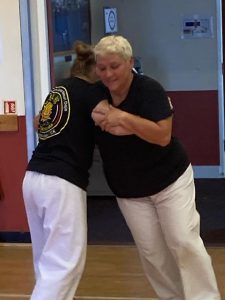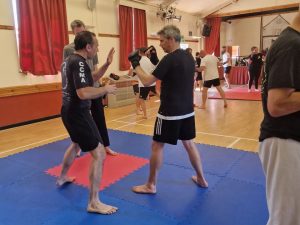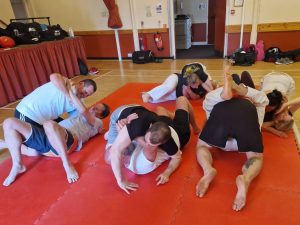Return of the Switch! (diary entry)
- jamie03066
- Jun 13, 2023
- 3 min read























11.06.2023 Following my children's self-protection seminar I got into three hours of martial arts cross training: Vagabond Warriors. At the request of Kuroten Practical Karate, my host, this seminar centred on "The Switch". For those unfamiliar with the cross-training concept, it trains switching rapidly between different areas. Just as we need to be able to transition seamlessly from striking to grappling, from stand-up to clinch to ground, from weapons to empty hand, from avoidance to preemption, from fighting to escape and all of these in reverse, so we need to understand how to be able to train both self-defence and match-fighting. I began the session with the idea of warming up with sparring. Using the acronym DBADS (Don't Be A Dick Sparring), the idea here that you work very lightly with your training partner. Although the work isn't drilling or compliant, the lightness of the movements allows both sides to activate muscles correctly and to focus more on technique without the extra stress found in a more competitive environment. This was performed on the ground and then with layered on strikes. Next, we moved onto one-for-one improvised ground drilling with 10 second intervals of more intensive sparring. This moved us into cross-training concepts. We began with Boxing - as it is a good a discipline as any to use as a combative starting point - and the pawing jab. This technique opens up a lot of interlinking martial arts and self-defence tactics and techniques. From a boxing perspective, the pawing jab not only sets a range but also obscures an opponent's vision. I linked it angling off to the blind side. We then looked at how this transfers to self-defence. John "Awesome" Anderson showed me a version of his fence where this could be used. It's a particularly aggressive fence where the user makes an immediate commitment and isn't deescalating the other person but even escalating them. The hand can work as a sensory tentacle as well, a core concept when using the fence. This opens up training into datum setting and referencing with a non-striking hand. In Boxing and Muay Thai it can draw out the guard, opening up the sides to circular attacks such as hooks and round kicks. We trained both in their respective styles and also looked at how Muay Thai their rear hand as a distraction or vision obstruction when delivering kicks. As was pointed out to me during the seminar, Muay Thai's long guard offers its own pawing jab and the technique can be extended as a posting or framing weapon. With hands being used to intercept guards, we were soon onto some trapping and into the clinch. Here we looked at Wrestling and Muay Thai variations for breaking an opponent's posture and again the use of angles. In addition to elbow strikes and knee strikes, we brought in "dirty boxing" shoulder bumps and knee bumps. Then we took it to the wall for a simple reversal combination of close range strikes. The session finished with a slightly more complex version of "The Switch". With two coaches on one student, we switched between a self-defence dynamic (asymmetrical forward pressure, seeking an exit) to a sport dynamic (back and forth, attack and defend, seeking dominance). However, this time we also brought in range transitioning. So, the trio needed to be aware of what range they were in (stand-up, clinch and ground) and their objective (self-defence or sport). We had a great turn out of students, all wonderfully organised by thoroughly the professional and inspirational Kuroten Karate team. https://clubbchimera.com/services/













Comments